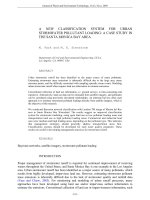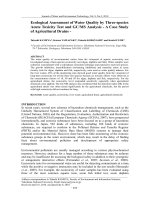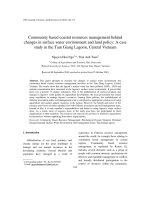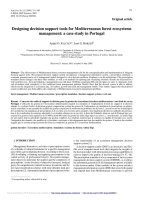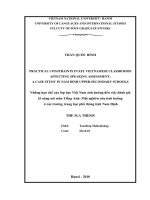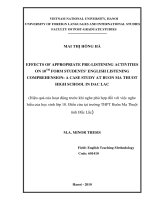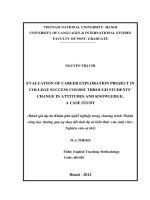substitution of fishmeal by soybean meal in diets for nile tilapia oreochromis niloticus a case study of rwanda
Bạn đang xem bản rút gọn của tài liệu. Xem và tải ngay bản đầy đủ của tài liệu tại đây (1.82 MB, 57 trang )
MINISTRY OF EDUCATION AND TRAINING
NHA TRANG UNIVERSITY
Substitution of fishmeal by soybean meal in diets for Nile
tilapia (Oreochromis niloticus): A Case study of Rwanda.
Aloys MUSONI
Master thesis
July, 2014
MINISTRY OF EDUCATION AND TRAINING
NHA TRANG UNIVERSITY
Substitution of fishmeal by soybean meal in diets for Nile
tilapia (Oreochromis niloticus): A Case study of Rwanda.
By
Aloys MUSONI
54CH344
Thesis submitted in partial fulfillment of the requirements
for the award of a Master of Science in Aquaculture
Supervisors:
Le Anh Tuan, PhD
Nguyen Van Minh, PhD
June 2014
i
Dedication
To:
God, for his mercies and faithfulness
My wife Odette Mukanyandwi, my children Sedric Byiringiro and Sabrine Isimbi
ii
Declaration
I hereby declare that this thesis has been produced by myself and is the result of my
own investigations. It has neither been accepted nor submitted for any other degree.
All sources of information have been accurately documented.
Aloys MUSONI
iii
Acknowledgements
First of all, I wish to express my appreciation to Almighty God for providing a safe
environment and strength a long way my studies in Nha Trang University (Vietnam).
My sincere gratitude goes to Dr. L. A. Tuan and Dr. N. V. Minh for their advice,
guidance and technical support of this thesis.
I wish to thank the Government of Rwanda which through PAIGELAC project
provided funds for these studies. Likewise, I would like to thank the Government of
Vietnam through Nha Trang University for offering admission in master’s
programme.
I take this opportunity to express my gratitude to all staff of Nha Trang University for
their help and creating a warm environment during my stay in Vietnam.
Finally, I would like to extend a heartfelt thank you to all students of Nha Trang
University for their moral support, kindness and friendship.
iv
Table of contents
Page
Dedication i
Declaration ii
Acknowledgements iii
Table of contents iv
Abstract vii
Abbreviation viii
List of tables ix
List of figures ix
Main parts of the thesis x
Introduction 1
Hypothesis and Research Objectives 3
Hypothesis 1 3
Objective 1 3
Hypothesis 2 3
Objective 2 3
Chapter 1: Literature review 4
1.1. World production and Aquaculture of tilapia 4
1.2. Tilapia Aquaculture in Africa 5
1.3. Status of Aquaculture in Rwanda 5
1.4. Perspective or potential of Aquaculture of Tilapia in Rwanda 6
1. 5. Culture systems of Tilapia 8
1.5.1. Cage culture 8
1.5.2. Pond culture 8
v
1.5.3. Raceways systems 8
1.5.4. Recirculating Systems 9
1.6. Environmental factors of Tilapia 9
1.6.1. Temperature 9
1.6.2. Salinity 10
1.6.3. pH and Ammonia 10
1.6.4. Dissolved Oxygen 10
1.7. Nutrient requirements for tilapia 11
1.7.1. Energetics 11
1.7.2. Protein 12
1.7.3. Lipid 12
1.7.4. Carbohydrate 13
1.7.5. Vitamin and minerals 13
1.7.6. Amino acid profile 14
1.8. Tilapia feed characteristics and feeding behavior 15
1.9. Reproduction of tilapia 16
1.10. Digestibility of soybean meal 17
1.11. Limitation of using soybean meal in tilapia diets 18
1.11.1. Trypsin inhibitors 18
1.11.2. Phytic acid 18
1.11.3. Oligosaccharides 19
1.11.4. Saponins 19
1.12. Replacement of fishmeal with soybean meal in feed for Nile tilapia 19
Chapter 2: Material and Methods 21
2.1. Study area 21
2.1.1. Geography and Climate of Rwanda 21
vi
2.1.2. Feeding trial at Kigembe Fish Farming Station 21
2.2. Experimental fish 22
2.3. Ingredients preparation and feed formulation 22
2.3.1. Protein analysis and procedure 23
2.3.2. Lipid analysis procedure 24
2.4. Feeding experiments 25
2.5. Growth parameters 26
2.6. Feed Conversion Ratio (FCR) 26
2.7. Statistical analysis 27
Chapter 3: Results and Discussion 28
3.1. Results 28
3.1.1. Water quality parameters 28
3.1.2. Growth, feed utilization (feed efficiency) and survival 28
3.1.3. Body crude protein (BCP) 31
3.2. Discussion 32
Chapter 4: Conclusion and Recommendations 35
4.1. Conclusion 35
4.2. Recommendations 35
References 36
vii
Abstract
A feeding trial was conducted at Kigembe fish farming station to determine the effect
of fishmeal replacement in the formulated feed by soybean meal on growth, feed
efficiency and survival for fry Nile tilapia (Oreochromis niloticus). Five experimental
diets were formulated to be isonitrogenous approximately. The diet 1 (control diet)
included 100% of fishmeal (FM) while for the other diets fishmeal was partially
replaced by soybean meal (diet 2, 75%FM & 25%SBM; diet 3, 50%FM & 50%SBM;
diet 4, 25%FM & 75%SBM; diet 5, 0%FM & 100%SBM). The fry of Nile tilapia
(body weight 1.34 ± 0.025g) were sorted and stocked into 5 treatments with triplicate
groups for each treatment. The experimental units were 15 hapas and all set up in one
pond. Feeding ration for each treatment was 10% of total fish biomass over the first 30
days which was divided and offered three times per day. The amount was reduced up
to 8% of the total fish biomass for the next 30 days while 6% of total fish biomass was
provided during the last 30 days. The results produced showed that the Mean weight
gain recorded for the fish fed with diet 2 (75%FM) and diet 3 (50%FM) were not
significantly different from that of the fish fed with the control diet (P>0.05).
Compared with the control diet, the results of specific growth rate (SGR) were
statistically significant (P<0.05) for fish fed with the diet 5 (0%FM) while for the
other diets (diet 2, 3 and 4) were not (P>0.05). The mean FCR recorded for the fish
fed different amount of SBM did not show a significant difference (P>0.05) compared
to the mean FCR recorded for the fish fed the control diet. The mean percentage
survival of fish fed with different experimental diets did not show a significant
difference (P>0.05). The results produced from body crude protein did not show a
significant difference among treatment (P >0.05). The results showed that the total
cost to prepare 1kg of feed was considerably reduced with increase in inclusion levels
of soybean meal in the diets. The results proved that up to 50% of the SBM could be
utilized by Tilapia safely and efficiently as alternative protein source in tilapia diets
when the mean weight gain, specific growth rate, feed conversion ratio, survival and
body crude protein are considered.
Key words: Oreochromis niloticus, Tilapia feed, feed formulation, fishmeal
replacement, soybean protein alternative.
viii
Abbreviation
AfDB: Africa Development Bank
AOAC: Association of Official Analytical Chemists
CGM: corn gluten meal
EAA: essential amino acids
FAO: Food and Agriculture Organization of the United Nations
FCR: feed conversion ratio
FFSB: full-fat soybean
FM: fish meal
IFFO: international fishmeal and fish oil organization
MINAGRI: Ministry of Agriculture and Animal Resources
MT: million metric tons (MT)
PAIGELAC: Inland Lakes Integrated Development and Management Support Project
PER: protein efficiency ratio
PPV: protein production value
RAB: Rwanda Agriculture Board
SBM: soybean meal
SGR: Specific Growth Rate
USAID: United States Agency for International Development
ix
List of tables
Page
Table 1.1: Limits and optima of water quality parameters for tilapia. 11
Table 2.1: Ingredients used for experimental diets (1,000g) 23
Table 2.2: Proximate composition of dietary ingredients used in experimental diets fed
to tilapia fry 24
Table 2.3: The proximate composition of protein and lipid in each experimental diet 25
Table 3. 1: Water quality parameters recorded during the experimental period 28
Table 3.2: Growth performance of fry Nile tilapia fed with experimental diets
containing Variable amounts of soybean meal in period of 3 months 29
Table 3.3: The crude protein percentages of Tilapia fish fed different experimental
diets and total cost to prepare 1 kg of each experimental diet considering the price of
each ingredient. 32
List of figures
Page
Figure 3.1: Effect of dietary fishmeal replacement with soybean meal on the Mean
Weight Gain of Fry Nile tilapia. 30
Figure 3.2: Total number of fish for different treatments during the experimental
period of 3 months 31
x
Main parts of the thesis
Chapter one of the present thesis includes a review of literature. Chapter two describes
the methodology used in this research thesis. Chapter three presents and discusses the
results obtained. Finally, Chapter four provides conclusion and recommendations.
1
Introduction
Tilapia are known as ‘‘aquatic chicken’’ because of their fast growth, good quality
flesh, disease resistance, adaptability to a wide range of environmental conditions,
ability to grow and reproduce in captivity, and feed on low trophic levels. Therefore,
they have become an excellent choice for aquaculture, especially in tropical and
subtropical environments [1].
A major determinant of successful growth and intensification of aquaculture
production depends on aquafeed. Feed is the single largest operating expense (30-
70%) in all types of intensive aquaculture farming [2].
The development of commercial aquafeeds has been traditionally based on fishmeal as
the main protein source due to its high protein content and balanced amino acid
profile. Fishmeal has the right combination of essential amino acids, fatty acids,
vitamins and minerals for fish growth [3].
Fishmeal has been the most expensive one among the ingredients used for feed
formulation. Fish made into fish meal are caught from the wild. The shortage in global
fishmeal production coupled with increased demand and competition for its use in
livestock and poultry feeds has further increased fishmeal prices [3].
Therefore, replacement of fishmeal with alternative proteins with sustainable supplier
or less expensive would be beneficial in reducing feed costs. Soybean meals widely
used as the most cost effective alternative for fishmeal in feeds formulated for many
fish species employed in aquaculture [4]. Proteins from soybean are widely available,
and economical with relatively high digestibility and energy contents [5].
The problem facing with in aquaculture industry is to reduce the inclusion rate of
fishmeal in aquafeeds and show the economical importance and environmental
friendly of replacing fishmeal in aquafeeds by less expensive plant protein source [6].
2
Soy protein concentrate (SPC) supplemented with L-methionine totally replaced fish
meal in low-fat diets without affecting nutrient utilization of rainbow trout [7]. Goda
et al. [8], comparatively studied growth performance of Nile tilapia and tilapia galilae
(Sarotherodon galilaeus, Linnaeus, 1758) fed on fishmeal free diets (100% fishmeal
replacement). They found that growth performance of Nile tilapia were reduced when
replaced fishmeal by soybean meal (SBM), full-fat soybean (FFSB) or corn gluten
meal (CGM) under ideal protein profile. The reduction of growth performance and
feed utilization was observed when the high levels (> 10%) of FFSB were
incorporated in fish diets. However, tilapia galilae (Sarotherodon galilaeus, Linnaeus,
1758) can well accept SBM and CGM diets; so much as fish fed SBM diet showed
higher Specific Growth Rate (SGR) and lower feed conversion ratio (FCR) than those
of fish meal (FM) group.
Most of the above studies have been conducted within closed indoor rearing systems
(i.e. Fish usually being reared within small artificial rearing tanks or aquaria within a
water recirculation system). It was therefore more important to conduct this study for
Nile tilapia (Oreochromis niloticus) in the same manner of fish farmers (in outdoor
pond).
The fishmeal used by Rwandan farmers to formulate aquafeeds are imported from
commercial sources, thus feed price increases, while soybean meal is locally available
in different parts of the country which can be used as an alternative protein source.
The aim of the present study is to evaluate the effect of replacement of fishmeal by
soybean meal on growth, feed conversion ratio (FCR) and survival rate, of tilapia for a
period of three months. The outcome of this study will be the design of the cheapest
fish feed and affordable by local farmers through using soybean meal as source of
protein in tilapia feed instead of using fishmeal.
3
Hypothesis and Research Objectives
Hypothesis 1
The formulated feed with soybean meal can nutritionally replace fish meal as main
source of protein without compromising growth performance of Nile tilapia.
Objective 1
Objective of this study is focusing to formulate a cheap balanced tilapia made feed by
replacing 100% of fishmeal (FM) protein with soybean meal protein and to determine
the effects on growth, feed conversion ratio (FCR) and survival rate, of tilapia for a
period of three months.
Hypothesis 2
Completed replacement of fishmeal with soybean meal as source of protein for Nile
tilapia is not acceptable due to its detrimental effects on fish.
Objective 2
To determine the maximum replacement levels of fish meal by soybean meal without
affecting growth rate, feed conversion ratio (FCR) and survival rate, of tilapia for a
period of three months.
4
Chapter 1: Literature review
1.1. World production and Aquaculture of tilapia
Aquaculture continues to grow rapidly than any other animal-producing sectors, with
an annual growth rate for the world of 8.8 percent since 1970, compared with only 1.2
percent for capture fisheries and 2.8 percent for terrestrial farmed meat production
systems over the same period [9].
The annual global total production of tilapia was less than 500,000 metric tons in the
early 1990s and reached 3.5 and 3.59 million metric tons in 2011 and 2012
respectively. In 2013 it was forecasted to climb 3.4 percent while in this year it should
approach around 3.9 million metric tons [10]. These observations indicate a
significant increment of tilapia production in the world. Most of the production came
from extensive /semi-intensive systems in developing countries, particularly in Asia
[11].
Tilapia is the second most important culture freshwater finfish in the world after the
carps. Currently, farmed tilapia represents more than 75% of world tilapia production
[11], and this contribution has been exponentially growing in recent years. Tilapia
plays an important role in food security and poverty alleviation in the developing
countries such as Indonesia, the Philippines, Thailand and China [12]. Several factors
have contributed to the rapid global growth of tilapia, such as cultured simple
technique and good adaptation to a wide range of environmental conditions.
Tilapia is one of the most important omnivorous fish species reared in aquaculture
systems. They are widely cultured in tropical and subtropical regions of the world
such as Egypt, Taiwan and Senegal. There are three genera of tilapia; Oreochromis,
Sarotherodon and Tilapia. The primary genus reared for aquaculture is Oreochromis
which includes Nile Tilapia (O. niloticus), Mozambique Tilapia (O. mossambicus),
and Blue Tilapia (O. aureus and O. urolepis hornorum) [13].
5
Tilapia found in the family of Cichlidae, is well adapted to enclosed water. The tilapia
is an omnivorous species that uses a wide spectrum of foods [14], efficiently uses
dietary carbohydrates and has a great ability to digest plant protein [15].
1.2. Tilapia Aquaculture in Africa
Although Tilapia species are native from Africa and the Middle East, Food insecurity
remains a serious problem in the developing world, particularly in Africa. This is due
to the low existing biotechnical, economic and institutional challenges, which include
lack of national policies to guide aquaculture development, unfriendly investment
policies, the absence of linkages between farmers, research/technology development
and extensions, and unfavorable investment climates [16].
Fortunately, there have been many attempts to promote aquaculture as a means to
address poverty and food insecurity in Africa, although with limited success. The
outlook in North Africa differs from that of sub-Saharan Africa and the Near East
largely due to the impact Egypt has in the region, almost half of total tilapia
production in Africa came from Egypt [17]. The farmers in this country operate on 1
to 2 ha earthen ponds, producing primarily O. niloticus.
Although there are no projections for North Africa or the Near East [18], in his review
of Egypt and in his regional review of North Africa and the Near East predicted
continued and sustained growth of tilapia aquaculture in those regions.
1.3. Status of Aquaculture in Rwanda
As a landlocked country, Rwanda’s aquaculture relies on its rich fresh water
resources. About 8% of the area is covered by water (210,000 ha), of which lakes
occupy 128,000 ha. The country’s lakes are the main source of fish production.
Principally, Rwanda has a large potential for aquaculture. Besides pond aquaculture in
watershed areas with sufficient water availability, the needed site conditions for cage
aquaculture are given in various lakes [19].
Until recently Rwanda has been more or less self-sufficient as regards food supplies.
However, the estimated population increase is greater than the rate of increase of food
6
production. Thus, the Government of Rwanda is taking various steps to stimulate
domestic food production, including strategic measures aimed to increase the
production of fish from the numerous subsistence-level ponds operated by small
groups of farmers throughout capture fisheries in lakes and aquaculture in ponds [19].
1.4. Perspective or potential of Aquaculture of Tilapia in Rwanda
Although, aquaculture in Rwanda had been introduced in 1949 by the Belgium
colonial, it has been promoted in 1983 by the National Fish Culture Project. This
project was bilaterally funded by the United States Agency for International
development (USAID) and the government of Rwanda. It continued through 1988 and
then reduced funding for a second phase that was part of a Natural Resources
Management Project. Other several previous fish culture projects had been operating
in Rwanda, including two that were funded by the Food and Agriculture Organization
of the United Nations (FAO) and one that was funded by the government of Canada,
but none of these projects demonstrated success due to the absence of linkages
between, research/technology development and extensions services [20].
Thereafter, the aquaculture in Rwanda has slowed down slightly between 1990 and
2004 may be due to the political issues [21]. After that period, the Inland Lakes
Integrated Development and Management Support Project (PAIGELAC), was
conceived in 2004 after when the government of Rwanda realized that inland water
bodies were degenerating. The capture fisheries were dwindling, the massive erosion
was silting the lakes and overfishing had reached hazardous levels. The ultimate goals
were to increase fish production, improve nutrition, ensure food security and improve
the incomes of the beneficiaries in a sustainable manner [21]. The project was funded
by the Africa Development Bank (AfDB). Initially, PAIGELAC project objectives
were focused on only fisheries development, management of inland lakes and water
sheds protection.
According to the Master plan (2011), the target production from fish farming (in both
intensive pond and cage culture) around 112,000 MT by 2020.
7
In order to attain the objective, the Government of Rwanda through the PAIGELAC
project, a total of 15 lakes with a surface area of 15,380ha restocked with 381,113 (in
each lake) of Tilapia niloticus fingerlings. However, at Midterm review it was realized
that capture fisheries only could not be sufficient to provide enough fish to the
growing Rwandan population. It was therefore recommended that the project extends
its activities in aquaculture development [19].
The low production from capture fisheries was estimated at 17,158 MT while the
statistical data from aquaculture sector were not considered due to the insignificant
production of the sector [11]. Due to the gap presented, the Government also invested
a lot of money in aquaculture by creating new ponds and rehabilitating the old ones as
sponsorship for fish farmers working as cooperatives. The project has rehabilitated
nearly 218 ha of fish ponds and had also stocked with Nile tilapia (Orechromis
niloticus) in May 2012. It was in this context that Kigembe Fish Farm was also
rehabilitated and expanded to become a modern tilapia fish hatchery center. The
center was supplied with fresh brood stock (Nile tilapia) from Lake Albert and some
form of selective breeding has also begun so as to ensure supply of good seed in
future. The hatchery has a capacity of producing up to 10 million fingerlings every
year. The project introduced also the cage culture techniques in lakes. A total of 678
cages with volume ranged between 8m
3
to 27m
3
were installed in Lake Bulera,
Ruhondo, Kivu and Muhazi for Tilapia intensive farming [22].
The main species cultured in Rwanda is Tilapia nilotica (Oreochromis niloticus).
Common carp are also raised in ponds, but on a very small scale. Tilapia macrochir
and T. rendalli are not fast growing species and experience elsewhere in Africa
suggests that growth rates of Tilapia macrochir and T. rendalli are generally only 0.5
g/day and never exceed 1 g/day, even with fertilization of the ponds and artificial
feeding [23]. Clarias carsonii occurs sometimes in ponds, but are not appreciated by
population.
8
One of the main bottlenecks in development of aquaculture in Rwanda is the all-year
round availability of fingerlings of suitable fast growing species for pond culture. At
present only fingerlings of Tilapia nilotica (Oreochromis niloticus) are recommended
and available at the Kigembe Fish Farming Station.
1. 5. Culture systems of Tilapia
Tilapia can be raised under a number of different culture systems including cages,
ponds, raceways, closed and semi-closed indoor recirculating systems. While each
culture system is unique and has many advantages and disadvantages, they all share
the common goal of efficient production [24].
1.5.1. Cage culture
The cages are used in circumstances where fish cannot be controlled without human
interaction. Lakes, streams, and reservoirs often require fish to be enclosed with wire
fabric or nylon netting which is attached to a rigid frame that may be suspended to a
floating platform or flotation devices [24]. Generally, good water quality is achieved
in cage systems which allow for higher stocking rates. The startup costs, maintenance,
and replacement costs of cages can be quite high [24]. As well, it is difficult to control
diseases, and production may be lost due to net damage.
1.5.2. Pond culture
The Ponds are used by small culturists and researchers because they are easy to
maintain and have low costs associated with them [24]. Production levels are directly
related to pond design including side slopes, drain structure and inflow lines, which
are needed to ensure adequate water levels at all times, provide proper drainage and
prevent vegetation growth within the pond [24].
1.5.3. Raceways systems
The production of tilapia in raceways, an enclosed channel system, is very efficient.
Raceways can accommodate extremely high densities of fish which can be maintained
due to the high rates of water flow (from gravity) resulting in exceptional water
quality [24].
9
1.5.4. Recirculating Systems
The systems known as recirculating systems, allow water to circulate within a number
of culture tanks passed through a settling column to remove solids, and a biofilter to
detoxify the ammonia produced by fish [24]. Recirculating systems can also be a
semi-closed system where small amounts of water are removed and replaced with
fresh water. Closed or semi-closed systems are beneficial for production of tilapia
species in countries that do not have warm year-round climates or have a shortage of
fresh water or available land [25]. Recirculating systems designs are based on cost-
effective water treatment. Culturing tilapia in recirculating systems has a number of
disadvantages. Complete diets must be formulated and a feeding system implemented
using either hand or a mechanical feeder. Depending on the type of system, pollution
of surrounding water or land with nutrients and organic matter may arise from water
and waste discharge [26]. Pumps, aerators, filters, CO
2
and heaters can be costly and
need constant maintenance [26]. Finally, with high stocking densities, fish are
subjected to increased stress which may result in disease outbreaks [26].
1.6. Environmental factors of Tilapia
This group of warm water, omnivorous species cultured throughout the world and
comprising a large portion of global production is various tilapia species
(Oreochromis and Tilapia sp.). These fish are native to Africa and the Middle East,
but have been cultured in tropical and temperate regions around the world. The Nile
tilapia will reportedly thrive in any aquatic habitat except for torrential river systems
and the major factors limiting its distribution are salinity and temperature [27]. Tilapia
can also tolerate dissolved oxygen, pH, and ammonia levels than most cultured
freshwater fishes can [1].
1.6.1. Temperature
Temperature is a major metabolic modifier for Tilapia fish. Optimal growing
temperatures are typically between 22°C (72° F) and 29°C (84°F); spawning normally
occurs at temperatures greater than 22°C (72°F). Most tilapia species are unable to
survive at temperatures below 10°C (50°F), and growth is poor below 20°C [28].
Oreochromis niloticus is described as having a high tolerance for a range of
10
temperatures, with a lower lethal limit of 8ºC and an upper limit of 42ºC. Temperature
tolerance not only depends on each species, but it also depends on the size of the
individual. Young fish, which are smaller in size than adults, are typically more
tolerant of high and low temperatures [29].
1.6.2. Salinity
In general, most tilapias are highly tolerant of saline waters, although salinity
tolerance differs among species. Nile tilapia is thought to be the least adaptable to
noticeable changes (direct transfer, 18 parts per thousand in salinity); Mozambique,
blue, and redbelly (T. zilli) are the most salt tolerant. With the exception of Nile
tilapia, other tilapia species can grow and reproduce at salinity concentrations of up to
36 parts per thousand, but optimal performance measures (reproduction and growth)
are attained at salinities up to 19 parts per thousand [1].
1.6.3. pH and Ammonia
Other water quality characteristics relevant to tilapia culture are pH and ammonia. In
general, tilapia can tolerate a pH range of 3.7 to 11, but best growth rates are achieved
between pH 7 to 9 [30]. Ammonia is toxic to tilapia at concentrations of 2.5 and 7.1
mg/L as unionized ammonia, respectively, for blue and Nile tilapia, and depresses
feed intake and growth at concentrations as below as 0.1 mg/L. Optimum
concentrations are estimated to be below 0.05 mg/L [31].
1.6.4. Dissolved Oxygen
Tilapia are, in general, highly tolerant of low dissolved oxygen concentration, even
down to 0.1 mg/L [32], but optimum Tilapia growth is obtained at concentrations
greater than 3 mg/L [30]. The following table summarizes the range and optimum for
growth of Nile tilapia.
11
Table 1.1: Limits and optima of water quality parameters for tilapia.
Parameter
Range
Optimum
for growth
Reference
Salinity, parts
per thousand
Up to 36
Up 19
[1]
Dissolved
oxygen, mg/L
Down to 0.1
> 3
[32]; [30]
Temperature,
C°
8–42
22–29
[28]
pH
3.7–11
7–9
[30]
Ammonia,
mg/L
Up to 7.1
< 0.05
[31]
1.7. Nutrient requirements for tilapia
The low trophic level and the omnivorous food habits of tilapia make them a relatively
inexpensive fish to feed, unlike other finfish, such as salmon, which rely on high
protein and lipid diets based on more expensive protein sources like fish meal. In
addition, tilapia are similar to channel catfish (Ictalurus punctatus), in that they can
tolerate higher dietary fiber and carbohydrate concentrations than most other cultured
fish. To ensure high yield and fast growth at least cost, a well-balanced prepared feed
is essential to successful tilapia culture [33].
1.7.1. Energetics
Energy is not a nutrient but is a property of nutrients that are released during the
metabolic oxidation of proteins, carbohydrates and lipids. Available data on energy
requirements of tilapias have been reported in terms of gross energy (GE), digestible
energy (DE) or metabolizable energy (ME) in relation to the dietary level of protein
[33]. As the digestible energy (DE) content in the diet increased, consumption by O.
niloticus decreased, but the amount of protein in the diet did not affect consumption
[34].
12
Energy needed for fish is significantly different than in mammals and birds. This is
due to 2 factors: 1) fish are poikilothermic and 2) energy expenditure to produce urea
or uric acid is avoided because fish excrete ammonia directly through their gills [35].
In terrestrial livestock, the energy losses due to the heat increment can be 20-30% of
the intake energy [36] while for fish this is only 5-15% of intake energy [37].
Furthermore, the maintenance energy requirements of fish are only 5-10% of those for
similar sized terrestrial livestock [38]. These differences mean that fish are
significantly more efficient in converting feed into body tissues than terrestrial species
if an optimal environment is provided.
1.7.2. Protein
Protein is responsible for a large part of the cost of most prepared diets. Generally,
protein is given the first priority in formulating fish diets because it is the most
expensive component of the prepared diets [39]. The protein requirement of tilapia
decreases with age and size, with higher dietary CP concentrations required for fry
(30–56%) and fingerlings (30–40%) tilapia but lower protein levels (28–30%) for
larger tilapia [40].
1.7.3. Lipid
Dietary lipids provide a major source of energy, facilitate the absorption of fat soluble
vitamins, play an important role in membrane structure and function, serve as
precursors for steroid hormones and prostaglandins, and serve as metabolizable
sources of essential fatty acids needed by fish for normal growth and development
[41]. Protein – sparing effects of non-protein nutrients such as lipids is necessary and
should be used to reduce diet costs and maximize nitrogen retention. Lipids, especially
phospholipids, are important for cellular structure and maintenance of membrane
flexibility and permeability [42]. Studies on T. Zillii [43] indicated that increasing
dietary lipid up to 15% resulted in a significant improvement in protein efficiency
ratio (PER) and protein production value (PPV). Dietary lipids have been shown to
have a sparing effect on the utilization of dietary protein. The level of protein in the
diet of O. niloticus can be reduced from 33.2% to 25.7% by increasing dietary lipid
from 5.7% to 9.4% and carbohydrate from 31.9% to 36.9% [42]. A right amount of fat
13
can improve taste and texture but excessive fat may pose a health hazard to fish. The
amount of 5% dietary lipid appeared to be sufficient to meet the minimal requirement
of juvenile tilapia, but a level of 12% was needed for maximal growth [44]. Similarly,
Jauncey [39], suggested that to maximize protein utilization, dietary fat concentration
should be between 8 and 12% for tilapia up to 25 g, and 6 to 8% for larger fish.
1.7.4. Carbohydrate
Carbohydrates are the least expensive form of dietary energy for human and domestic
animals, but their utilization by fish varies and remains somewhat obscure. It provides
energy but most of them are not easily digested by ordinary carnivorous marine
species such as grouper, red snapper and mangrove snapper. Fish in general utilizes
dietary carbohydrate poorly. No dietary requirement of carbohydrate has been
demonstrated in fish. It has been reported that the utilization of starch was
significantly higher than that of glucose for tilapia. It has also been reported that
tilapia utilizes disaccharides better than glucose but more poorly than starch [45].
Carbohydrates provide a relatively inexpensive source of energy compared to protein,
and their inclusion can improve the quality of pelleted feeds. Tilapia can effectively
utilize carbohydrate levels up to 30 to 40% in the diet, which is considerably more
than most cultured fish [46]. Fiber is usually considered indigestible, as tilapia does
not possess the required enzymes for fiber digestion (although some cellulase activity
from microbes has been found in the gut of O. mossambicus [47]. For this reason, and
to attain maximum growth, crude fiber levels in tilapia diets should probably not
exceed 5% [46].
1.7.5. Vitamin and minerals
Vitamins are organic substances that are essential for growth, health, reproduction and
maintenance in animals, but required in small amounts. Since fish cannot synthesize
vitamins at all or can only synthesize in insufficient quantity for normal development,
growth and maintenance, they must be supplied in the diet. Other than the 13 known
vitamins, i.e. thiamin, riboflavin, niacin, pantothenic acid, biotic, folic acid, vitamin
B6, B12, C, A, D, E, and K their requirements have been quantified for tilapia [48].
